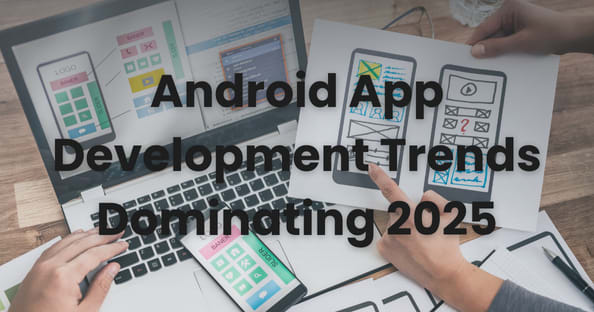The Android ecosystem is undergoing one of its most transformative evolutions in a decade. With the convergence of generative AI, 5G networks, foldable devices, and Google’s accelerated support for Kotlin Multiplatform and Jetpack Compose, Android development in 2025 is no longer just about building apps—it’s about engineering adaptive, intelligent experiences that live across screens, devices, and environments.
So what exactly is driving this shift?
In 2025, mobile app development trends are being shaped by a blend of technical innovation, user behavior shifts, and systemic changes in the way software is designed, deployed, and secured. Developers and decision-makers are now expected to think beyond performance and UI, embracing personalization, cross-platform logic, privacy-by-design principles, and ecosystem interoperability. At the same time, new tools like on-device AI and edge computing are enabling apps to become smarter, faster, and more privacy-conscious without relying heavily on the cloud.
For founders, CTOs, and product leaders, the implications are profound. The Android apps of the near future won’t just be reactive—they’ll be predictive, context-aware, and tightly integrated with everything from wearables and vehicles to IoT sensors and spatial computing environments.
This blog explores the top Android app development trends of 2025, supported by real-world use cases and a forward-looking analysis of how these shifts are redefining the mobile development ecosystem.
This guide will help you no matter what path you choose, whether it is to refine your product roadmap or evaluate technical investment areas.
Android App Development Trends in 2025
1. AI in Android App Development: From Utility to Core Strategy
Artificial Intelligence is no longer an add-on in mobile applications—it’s fast becoming the nucleus of Android app architecture. In 2025, Android apps are expected to leverage AI at multiple levels: from powering personalized content feeds to driving real-time sentiment analysis, on-device recommendations, and adaptive user interfaces.
Google’s ML Kit and TensorFlow Lite are making it easier than ever to run powerful machine learning models directly on Android devices, eliminating cloud latency and boosting privacy. This has enormous implications for productivity tools, health apps, fintech platforms, and more.
With advancements in multimodal AI and the rise of small language models (SLMs), developers can now embed intelligent features such as voice-driven assistants, AI copilots, dynamic onboarding, and predictive search—all without draining the battery or exposing user data.
AI in Android is no longer optional. In 2025, it’s foundational to both user retention and product differentiation.
2. Kotlin Multiplatform: Redefining Code Reusability
Kotlin Multiplatform (KMP) has moved out of early adoption and into enterprise readiness. As Google continues to promote Kotlin as the preferred language for Android development, more teams are using KMP to share code across Android, iOS, and even backend systems.
In 2025, Kotlin Multiplatform isn’t just a developer productivity tool—it’s a strategic asset. Companies aiming to optimize engineering costs without compromising native performance are increasingly shifting to KMP for their business logic, networking layers, and domain models.
>> Read this blog to understand the mobile app development costs.
The real benefit is that the teams can reduce duplication and streamline QA cycles, all while delivering high-performance Android experiences. KMP is particularly effective when paired with Jetpack Compose and other modern Android libraries, allowing for cleaner, more maintainable codebases that scale across platforms.
3. Jetpack Compose: The Declarative Standard
Jetpack Compose has fully graduated from a “new” UI toolkit to the de facto way to build Android interfaces. Backed by material design support, Compose enables declarative UI development, where interface changes are driven by data state rather than imperative commands.
In 2025, Jetpack Compose will be the foundation of most modern Android apps, offering advantages like:
- Less boilerplate code
- Native animation support
- Integrated testing
- Real-time UI previews
It’s also better suited for foldables, wearables, and multi-device interactions thanks to its flexibility and modular architecture. For design and dev teams, Compose introduces a new level of collaboration—developers can iterate faster while maintaining consistent, scalable visual systems.
Compose isn’t just a trend, it’s Android’s new visual language.
4. Foldable UIs and Multi-Form Factor Experiences
Foldables are no longer niche devices. With hardware from Samsung, Google, and others gaining traction, Android developers are rethinking how apps behave across multiple form factors.
2025 is the year when multi-screen and resizable UI becomes table stakes. Android 14+ introduces robust APIs for window management, multi-resume, and layout optimization, enabling seamless transitions between folded and unfolded modes.
This opens up new UX paradigms:
- App continuity between phone and tablet states
- Split-screen multitasking
- Adaptive navigation flows
Designing for foldables also pushes developers toward more flexible architecture patterns and responsive layouts, many of which align naturally with Jetpack Compose.
For product leaders, supporting foldable UIs in 2025 is a forward-compatible move that ensures relevance across evolving Android hardware.
5. 5G-Optimized App Experiences
5G has officially moved from buzzword to infrastructure in 2025—and Android apps are increasingly built with this in mind.
Faster data rates and low latency open the door for:
- Ultra-HD video streaming
- Real-time multiplayer gaming
- Cloud-rendered 3D apps
- Instant AR overlays for navigation or shopping
Instead of optimizing for offline-first alone, developers are now considering network-aware design, where apps adapt their features, content delivery, and resolution dynamically based on the user’s connection speed.
For instance, an AR-powered retail app could switch from basic 2D previews to immersive 3D experiences as soon as it detects a stable 5G connection.
In 2025, ignoring 5G’s capabilities means underutilizing Android’s full potential for engagement and immersion.
6. On-Device Privacy & Federated Learning: Secure by Design
One of the most powerful mobile app development trends in 2025 is the shift toward on-device data processing. With Android tightening its privacy policies and global regulations like the CCPA and GDPR influencing app architecture, developers are prioritizing privacy-first design.
Technologies like Federated Learning, already used in Android’s Gboard, allow apps to improve personalization without exporting user data to the cloud. This supports the growing demand for secure, AI-driven mobile app trends that protect user trust while enhancing the experience.
In the future of mobile app development, privacy won’t be a feature—it will be a default standard. Product teams that invest in privacy-preserving architecture will be better positioned to meet both regulatory and user expectations.
7. Edge Computing in Android Apps: Smarter, Faster, Local
Edge computing has moved from buzzword to business enabler. As one of the more advanced mobile app development trends 2025 is witnessing, it allows for low-latency, high-performance computing on the device itself—or closer to the user, via edge nodes.
This is especially impactful for industries like logistics, healthcare, retail, and smart homes. Imagine an Android app that analyzes warehouse inventory in real time or processes biometric signals from a smartwatch without sending data to the cloud.
These are no longer theoretical use cases—they’re becoming standard. The future of app development enables apps to work even in poor connectivity scenarios while reducing server loads and operational costs.
For U.S.-based companies leveraging IoT or location-driven features, integrating edge computing into Android apps is now a competitive advantage, not an experiment.
8. Generative AI Integration: Android Gets Creative
The biggest disruptor in mobile app trends this year is undoubtedly Generative AI. In 2025, Android developers are embedding Gen AI models into apps to generate everything from text and images to voice, music, and even micro-interactions.
Google’s Gemini and open-source LLMs optimized for mobile are making this possible. Use cases include:
- Creative content apps (writing, drawing, music)
- AI-driven chat interfaces and code generators
- Voice-based note-taking and summarization tools
This isn’t just about AI—it’s about how AI in app development is redefining what apps can do. Developers can now deliver context-aware, human-like interactions without sending data to external APIs.
For founders and CTOs, integrating Gen AI offers a massive UX and engagement boost, aligning directly with the most innovative mobile app development trends emerging in the industry today.
9. AR/VR and Spatial Android Experiences
As spatial computing continues to evolve, AR and VR are carving out a mainstream role in Android’s growth trajectory. With Google’s ARCore and tools like Sceneform, Android developers now have more power to build immersive mobile app experiences than ever before.
In 2025, mobile app development trends will include:
- AR navigation in malls, airports, and campuses
- Virtual try-on for retail apps
- Interactive 3D learning platforms
- Real estate apps with immersive walkthroughs
For businesses targeting the future of mobile app development, AR and VR aren’t gimmicks—they’re utility layers. And with Android’s support for camera APIs, SLAM algorithms, and real-time rendering, the barrier to entry for spatial features is rapidly shrinking.
10. Android Auto, Wear OS & Multi-Surface Ecosystem Apps
The Android experience has moved far beyond smartphones. In 2025, a major focus of mobile app development trends is creating apps that adapt across surfaces: cars, watches, TVs, foldables, and even smart glasses.
Android Auto now supports context-aware voice commands, dynamic UI for in-car displays, and seamless transitions from mobile to vehicle. Similarly, Wear OS apps are being used in fitness, healthcare, and ambient computing scenarios.
Building for this ecosystem means:
- Designing responsive layouts with Jetpack Compose
- Syncing data across devices using Google APIs
- Thinking beyond tap-and-scroll interfaces
This shift is a defining pillar of the future of app development. Developers and founders who embrace this ecosystem-first mindset will futureproof their products and better engage users where they are—not just on phones, but everywhere Android lives.
Case Studies – Brands Driving Android App Innovation

1. Duolingo: AI-Powered Personalization at Scale
Duolingo, the world’s most downloaded education app, has become a textbook example of how AI in app development can drive user engagement and retention. The company integrated on-device machine learning models within its Android app to personalize learning pathways based on user behavior, language proficiency, and response times.
In 2023, Duolingo reported a 62% increase in daily active users (DAU) and credited much of this growth to improvements in app personalization and gamification—both powered by AI and predictive modeling. By 2025, Duolingo’s roadmap emphasizes localized learning agents powered by mobile-first LLMs, setting a benchmark for adaptive education apps.
Their use of AI as a mobile app trend illustrates how data-driven UX—optimized for performance and privacy—can create massive business outcomes, especially when deployed through Android’s on-device intelligence ecosystem.
2. Samsung: Building for Foldables with Jetpack Compose
Samsung, the global leader in foldable devices, has reshaped the conversation around foldable UIs and multi-screen Android experiences. Its native Android apps (like Samsung Notes, Smart Switch, and Samsung Health) are now fully optimized for foldable transitions, drag-and-drop, and dual-pane layouts.
The company’s developer relations team has collaborated with Google to push adoption of Jetpack Compose and large-screen responsive design principles. As of 2024, over 30% of new Android devices shipped in South Korea were foldables, and global foldable smartphone shipments are projected to reach 55 million units by 2025 (Statista).
Samsung’s commitment to device-fluid experiences illustrates one of the most critical mobile app development trends 2025 will mainstream: designing once for all form factors—without sacrificing UX.
3. Uber Freight: Edge Computing for Real-Time Logistics
Uber Freight has leveraged edge computing and low-latency mobile architecture to power its Android driver app, which supports real-time route optimization, load tracking, and ETA predictions. These features are critical for a logistics network that spans over 70,000 carriers in the U.S. alone.
By processing location and traffic data on-device, Uber reduces the dependency on constant cloud communication, improving reliability in areas with unstable connectivity (a common challenge in long-haul transport). This approach also reduces energy consumption and data privacy risks.
In 2025, Uber Freight’s edge-first architecture exemplifies how companies are adapting the future of mobile app development to suit operational complexity, particularly where milliseconds matter.
Their case proves that mobile app development trends like edge computing are not just theoretical—they’re mission-critical in industries where efficiency and uptime directly impact the bottom line.
How will these trends impact the android development ecosystem?
The rise of these mobile app development trends isn’t just changing what apps can do—it’s redefining how they’re built, who builds them, and what tools teams rely on.
Shift Toward Cross-Functional Development
The adoption of Kotlin Multiplatform and Jetpack Compose is streamlining collaboration between Android and iOS teams. Instead of building siloed codebases, developers are sharing business logic and component libraries across platforms, reducing duplication and increasing release velocity.
AI-First Thinking in Product Strategy
Product managers and designers are now planning features around AI capabilities from the start. This shift is transforming Android from a reactive system to a predictive, context-aware platform, where personalization, automation, and generative content are core to the app’s value.
Performance-Centric Architecture
Trends like 5G optimization, edge computing, and on-device privacy are driving architectural change. Teams are restructuring how data flows through their apps—balancing cloud interactions with localized processing to improve speed, resilience, and compliance.
Talent and Tooling Evolution
With these trends, there’s growing demand for developers (especially from India) skilled in:
- Declarative UIs (Jetpack Compose)
- AI/ML integration (ML Kit, TensorFlow Lite)
- Cross-platform logic (Kotlin Multiplatform)
- Spatial interfaces (ARCore)
CI/CD pipelines, security testing tools, and UX design systems are also evolving to support this future of app development.
For Android teams in 2025, embracing these shifts isn’t optional—it’s the key to staying competitive in a fast-moving, ecosystem-driven world.
Conclusion
In 2025, Android development is no longer just about creating apps—it’s about engineering intelligent, adaptive, and ecosystem-aware experiences that meet users wherever they are. From AI-powered personalization and Kotlin-powered cross-platform codebases to foldable interfaces and privacy-first design, the mobile app development trends shaping this year are both evolutionary and transformative.
What sets this moment apart is the speed of convergence. The maturity of tools like Jetpack Compose, the rising dominance of on-device AI, and the demand for 5G-native, multi-surface experiences mean that Android development now requires strategic foresight, not just technical proficiency.
For U.S.-based founders, product leads, and CTOs, this is the time to re-evaluate how your Android roadmap aligns with where the ecosystem is heading. You can always choose to partner with an Android app development company who have the expertise in mobile app development they will serve your requirements. Whether you’re building your first app or scaling a complex platform, the trends outlined here are more than just ideas—they’re operational blueprints for the future of mobile app development.
FAQs
Q1. What are the biggest Android app development trends in 2025?
The top mobile app development trends 2025 include AI-driven personalization, Kotlin Multiplatform, Jetpack Compose for UI, foldable UI design, 5G optimization, edge computing, and ecosystem expansion across Android Auto, Wear OS, and AR/VR.
Q2. How is AI shaping the future of mobile app development?
AI is becoming foundational in Android apps—powering real-time recommendations, voice interfaces, predictive search, and generative content. In 2025, AI is integrated directly into the development process and user experience, marking a major shift in the future of app development.
Q3. Why is Kotlin Multiplatform important for Android teams?
Kotlin Multiplatform allows developers to share core logic between Android, iOS, and backend services. It’s a key strategy in reducing tech debt and speeding up cross-platform development—making it one of the most impactful mobile app trends of the year.
Q4. Are foldable UIs worth designing for in 2025?
Yes. Foldables are gaining traction globally, especially in the U.S. and Asia. Android 14+ provides better APIs for resizable layouts and screen transitions. Supporting foldables now helps future-proof your app against evolving device form factors.
Q5. How do these trends affect long-term app development strategy?
They require a more adaptive, privacy-aware, and performance-optimized approach. Teams must modernize their stack, invest in AI and edge capabilities, and adopt frameworks like Jetpack Compose to remain competitive in the evolving mobile app development landscape.


